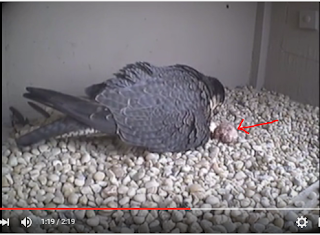Weekend Power Outage + The Scoop on Poop
On another note, cooler weather since mid-week has put Durand back into full brooding mode, except with the chicks growing fast, she is not able to cover them as completely as when they were smaller. But as they get older they aren't as vulnerable to being chilled and by all huddling together they help to keep each other warm also.
Now the scoop on poop: (Caution: some content beyond this point may not be suitable for all audiences!)
Most people are used to watching a common songbird nest such as an American robin in a backyard tree or shrub. Well, did you know that for those types of birds when they defecate, it is in the form of a fecal "sac" - that is, the fecal material is contained within a membrane that makes it easy for the adult bird to pick up the poop and carry it away for disposal elsewhere, so it does not contaminate the nest.
This is done when the nestlings are very young. As the nestlings grow they develop the strength and motor skills to position themselves so they can defecate up and over the rim and thus, outside of the nest. This system helps to keep a songbird nest relatively clean of feces while the young birds grow.
In the case of peregrine chicks, they position themselves to defecate away from the scrape. When they are very small they are generally facing in towards each other so their waste naturally is away from the scrape. As they grow and gain more strength, they will specifically turn away from the scrape. As they get older still, the propulsion of the feces increases (as does the amount and frequency!) and it is then we can begin to see evidence of it inside the nest box.
Here is a photo I just saved this morning and already there is a noticeable splattering of feces on the back wall of the nest box. As the nesting season progresses, the inside walls of the nest box will literally become caked with fecal material. Veteran viewers will remember that we can expect the chicks to hit the front of the nest box camera housing at some point, which usually obscures the view from that camera. So, there is probably more than you thought you were going to learn in one day about "avian feces management"!
One final note, there is a Civil War Encampment on the grounds of the Ohio Statehouse today that will include regular cannon firings. Viewers may hear the cannon blasts via the live streaming but shouldn't be alarmed. The loud noise to the falcons is no different than a clap of thunder during a storm.



















